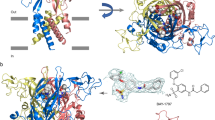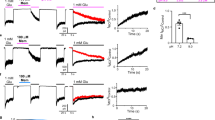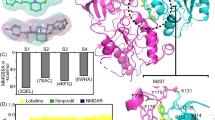Abstract
The phenylethanolamines, ifenprodil and CP-101,606, are NMDA receptor antagonists with promising neuroprotective properties. In recombinant NMDA receptors expressed in Xenopus oocytes, we found that these drugs inhibit NMDA receptors through a unique mechanism, making the receptor more sensitive to inhibition by protons, an endogenous negative modulator. These findings support a critical role for the proton sensor in gating the NMDA receptor and point the way to identifying a context-dependent NMDA receptor antagonist that is inactive at physiological pH, but is a potent inhibitor during the acidic conditions that arise during epilepsy, ischemia and brain trauma.
This is a preview of subscription content, access via your institution
Access options
Subscribe to this journal
Receive 12 print issues and online access
$209.00 per year
only $17.42 per issue
Buy this article
- Purchase on Springer Link
- Instant access to full article PDF
Prices may be subject to local taxes which are calculated during checkout







Similar content being viewed by others
References
Choi, D. W. Excitotoxic cell death. J. Neurobiol. 23, 1261–1276 (1992).
Dingledine, R., McBain, C. J. & McNamara, J. O. Excitatory amino acid receptors in epilepsy. Trends Pharmacol. Sci. 11, 334–338 (1990).
Meldrum, B. & Garthwaite, J. Excitatory amino acid neurotoxicity and neurodegenerative disease. Trends Pharmacol. Sci. 11, 379–387 (1990).
Giffard, R. G., Monyer, H., Christine, C. W. & Choi, D. W. Acidosis reduces NMDA receptor activation, glutamate neurotoxicity, and oxygen-glucose deprivation neuronal injury in cortical cultures. Brain Res. 506, 339–342 (1990).
Tang, C.-M, Dichter, M. & Morad, M. Modulation of the N-methyl-D-aspartate channel by extracellular H+. Proc. Natl. Acad. Sci. USA 87, 6445–6449 (1990).
Traynelis, S. F. & Cull-Candy, S. G. Proton inhibition of N-methyl-D-aspartate receptors in cerebellar neurons. Nature 345, 347–350 ( 1990).
Traynelis, S. F. & Cull-Candy, S. G. Pharmacological properties and H+ sensitivity of excitatory amino acid receptor channels in rat cerebellar granule neurones. J. Physiol. (Lond.) 433, 727–763 ( 1991).
Vyklick´y, L. Jr, Vlachová, V. & Krusek, J. The effect of external pH changes on responses to excitatory amino acids in mouse hippocampal neurones. J. Physiol. (Lond.) 430, 497– 517 (1990).
Chesler, M. & Kaila, K. Modulation of pH by neuronal activity. Trends Neurosci. 15, 396– 402 (1992).
Siesjo, B. K. Acid-base homoeostasis in the brain: physiology, chemistry and neurochemical pathology. Prog. Brain Res. 63, 121– 153 (1985).
Silver, I. A. & Erecinska, M. Ion homeostasis in rat brain in vivo: intra- and extracellular [Ca2+] and [H+] in the hippocampus during recovery from short-term, transient ischemia. J. Cereb. Blood Flow Metab. 12, 759– 772 (1992).
Kaku, D. A., Giffard, R. G. & Choi, D. W. Neuroprotective effects of glutamate antagonists and extracellular acidity. Science 260, 1516–1518 (1993).
Carter, C. J. et al. Ifenprodil and SL 82.0175 as cerebral anti-ischemic agents. II. Evidence for N-methyl-D-aspartate receptor antagonist properties. J. Pharmacol. Exp. Ther. 247, 1222– 1232 (1988).
Williams, K. Ifenprodil discriminates subtypes of the N-methyl-D-aspartate receptor: Selectivity and mechanisms at recombinant heteromeric receptors. Mol. Pharmacol. 44, 851–859 ( 1993).
Williams, K. Pharmacological properties of recombinant N-methyl-D-aspartate (NMDA) receptors containing the ε4 (NR2D) subunit. Neurosci. Lett. 184, 181–184 (1995).
Blahos, J. 2nd & Wenthold, R. J. Relationship between N-methyl-D-aspartate receptor NR1 splice variants and NR2 subunits. J. Biol. Chem. 271, 15669– 15674 (1996).
Luo, J., Wang, Y., Yasuda, R. P., Dunah, A. W. & Wolfe, B. B. The majority of N-methyl-D-aspartate receptor complexes in adult rat cerebral cortex contain at least three different subunits (NR1/NR2A/NR2B). Mol. Pharmacol. 51, 79– 86 (1997).
Graham, D., Darles, G. & Langer, S. Z. The neuroprotective properties of ifenprodil, a novel NMDA receptor antagonist, in neuronal cell culture toxicity studies. Eur. J. Pharmacol. 226, 373–376 (1992).
Gotti, B. et al. Ifenprodil and SL 82.0715 as cerebral anti-ischemic agents. I. Evidence for efficacy in models of focal cerebral ischemia. J. Pharmacol. Exp. Ther. 247, 1211–1221 (1988).
Tamura, Y. et al. Ifenprodil prevents glutamate cytotoxicity via polyamine modulatory sites of N-methyl-D-aspartate receptors in cultured cortical neurons. J. Pharmacol. Exp. Ther. 265, 1017– 1025 (1993).
Reynolds, I. J. & Miller, R. J. Ifenprodil is a novel type of N-methyl-D-aspartate receptor antagonist: interaction with polyamines. Mol. Pharmacol. 36, 758– 765 (1989).
Carter, C. J., Lloyd, K. G., Zivkovic, B. & Scatton, B. Ifenprodil and SL 82.0715 as cerebral antiischemic agents. III. Evidence for antagonistic effects at the polyamine modulatory site within the N-methyl-D-aspartate receptor complex. J. Pharmacol. Exp. Ther. 253, 475–482 (1990).
Legendre, P. & Westbrook, G. L. Ifenprodil blocks N-methyl-D-aspartate receptors by a two-component mechanism. Mol. Pharmacol. 40, 289–298 (1991).
Kew, J. N. C., Trube, G. & Kemp, J. A. A novel mechanism of activity-dependent NMDA receptor antagonism describes the effect of ifenprodil in rat cultured cortical neurones. J. Physiol. (Lond.) 497, 761– 772 (1996).
Chenard, B. L. et al. Separation of α adrenergic and N-methyl-D-aspartate antagonist activity in a series of ifenprodil compounds. J. Med. Chem. 34, 3085–3090 ( 1991).
McCool, B. A. & Lovinger, D. M. Ifenprodil inhibition of the 5-hydroxytryptamine3 receptor. Neuropharmacology 34, 621–629 (1995).
Fischer, G. et al. Ro 25–6981, a highly potent and selective blocker of N-methyl-D-aspartate receptors containing the NR2B subunit. Characterization in vitro. J. Pharmacol. Exp. Ther. 283, 1285–1292 (1997).
Kew, J. N. C., Trube, G. & Kemp, J. A. State-dependent NMDA receptor antagonism by Ro 8-4304, a novel NR2B selective, non-competitive, voltage-independent antagonist. Brit. J. Pharmacol. 123, 463–472 (1998).
Chenard, B. L. et al. (1S,2S)-1-(4-hydroxyphenyl)-2-(4-hydroxy-4-phenylpiperidino)-1-propanol: a potent new neuroprotectant which blocks N-methyl-D-aspartate responses. J. Med. Chem. 38, 3138– 3145 (1995).
Williams, K., Russell, S. L., Shen, Y. M. & Molinoff, P. B. Developmental switch in the expression of NMDA receptors occurs in vivo and in vitro. Neuron 10, 267 –278 (1993).
Menniti, F. et al. CP-101,606, a potent neuroprotectant selective for forebrain neurons. Eur. J. Pharmacol. 331, 117– 126 (1997).
Kleckner, N. W. & Dingledine, R. Requirement for glycine in activation of NMDA receptors expressed in Xenopus oocytes. Science 241, 835–837 (1988).
Traynelis, S. F., Burgess, M. F., Zheng, F., Lyuboslavsky, P. & Powers, J. L. Control of voltage-independent zinc inhibition of NMDA receptors by the NR1 subunit. J. Neurosci. 18, 6163–6175 ( 1998).
Traynelis, S. F., Hartley, M. & Heinemann, S. F. Control of proton sensitivity of the NMDA receptor by RNA splicing and polyamines. Science 268, 873–876 (1995).
Sullivan, J. M. et al. Identification of two cysteine residues that are required for redox modulation of the NMDA subtype of glutamate receptor. Neuron 13, 929–936 ( 1994).
Williams, K., Kashiwagi, K., Fukuchi, J. & Igarashi, K. An acidic amino acid in the N-methyl-D aspartate receptor that is important for spermine stimulation. Mol. Pharmacol. 48, 1087–1097 (1995).
Kashiwagi, K., Fukuchi, J.-I., Chao, J., Igarashi, K. & Williams, K. An aspartate residue in the extracellular loop of the N-methyl-D-aspartate receptor controls sensitivity to spermine and protons. Mol. Pharmacol. 49, 1131– 1141 (1996).
Pahk, A. J. & Williams, K. Influence of extracellular pH on inhibition by ifenprodil at N-methyl-D-aspartate receptors in Xenopus oocytes. Neurosci. Lett. 225, 29– 32 (1997).
Gallagher, M. J., Huang, H., Pritchett, D. R. & Lynch, D. R. Interactions between ifenprodil and the NR2B subunit of the N-methyl-D-aspartate receptor. J. Biol. Chem. 271, 9603– 9611 (1996).
Root, M. J. & MacKinnon, R. Two identical noninteracting sites in an ion channel revealed by proton transfer. Science 265, 1852–1856 (1994).
Davis, S. M., Albers, G. W., Diener, H.-C., Lees, K. R. & Norris, J. Termination of acute stroke studies involving selfotel treatment. Lancet 349, 32 (1997).
Lees, K. R. Cerestat and other NMDA antagonists in ischemic stroke. Neurology 49, S66–S69 ( 1997).
Bath, C. P. et al. The effects of ifenprodil and eliprodil on voltage-dependent Ca2+ channels and in gerbil global cerebral ischemia. Eur. J. Pharmacol. 299, 103–112 (1996).
Biton, B., Godet, D., Granger, P. & Avenet, P. R- and L-type Ca2+ channels are insensitive to eliprodil in rat cultured cerebellar neurons. Eur J. Pharmacol. 323, 277– 281 (1997).
Pasternack, M., Smirnov, S. & Kaila, K. Proton modulation of functionally distinct GABA A receptors in acutely isolated pyramidal neurons of rat hippocampus. Neuropharmacology 35, 1279– 1288 (1996).
Traynelis, S. F. in pH and Brain Function (eds Kaila, K. & Ransom, B. R.) 407–437 (Wiley-Liss, New York, 1998 ).
Dingledine, R., Hume, R. I. & Heinemann, S. F. Structural determinants of barium permeation and rectification in non-NMDA glutamate receptor channels. J. Neurosci. 12, 4080–4087 ( 1992).
Hoch, D. B. & Dingledine, R. GABAergic neurons in rat hippocampal culture. Dev. Brain Res. 25, 53– 64 (1986).
Acknowledgements
We thank Pfizer, Inc. for the gift of CP-101,606, S. Nakanishi, K. Moriyoshi, Stephen Heinemann and Keith Williams for NMDA receptor clones or mutants, James B. Revennaugh for technical assistance, Nancy F. Ciliax for preparing neuronal cultures and Kimberley Lindsey for work on early neuroprotection experiments. We also thank Keith Williams for pointing out the pH dependence of the E181Q mutation and for comments on the manuscript. This work was supported by AES/EFA Fellowships (D.D.M. and J.J.D.), the NIH (R.D. and S.F.T.), the John Merck Fund (S.F.T.) and Bristol-Myers Squibb (R.D.).
Author information
Authors and Affiliations
Corresponding author
Rights and permissions
About this article
Cite this article
Mott, D., Doherty, J., Zhang, S. et al. Phenylethanolamines inhibit NMDA receptors by enhancing proton inhibition . Nat Neurosci 1, 659–667 (1998). https://doi.org/10.1038/3661
Received:
Accepted:
Issue Date:
DOI: https://doi.org/10.1038/3661



